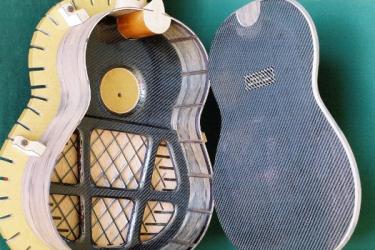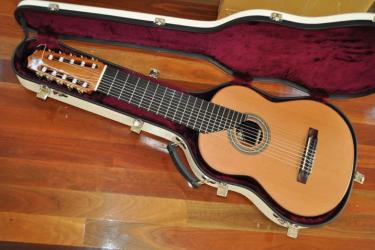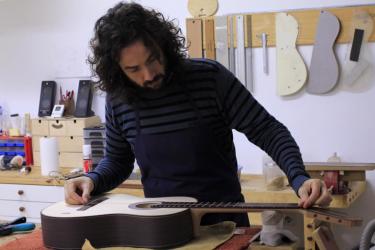
I’m delighted to have Gregory Byers from California, USA.
Q1. Could you please tell us a little about your luthiery and its history?
I began making classical guitars over 30 years ago. In the beginning I learned through workshops with José Romanillos, as well as advice from John Gilbert. I have developed my craft along a middle road from these two influences of the engineer and the intuitive traditionalist. I use old and new tools and methods, always with the goal of achieving, through exacting craftsmanship, superb playability and sound. I have been fortunate to have had my guitars in the hands of many brilliant players, from David Russell and David Tanenbaum, to Kevin Gallegher, René Izquierdo, and Johannes Möller. They and the many other players for whom I have built guitars have been my teachers along the way.
Q2. Please describe your idea of a good sounding guitar, and what you do to achieve it?
Here is what I work toward: a big sound, very even and sustaining, of great clarity and depth, yet warm and dark. I look for a quick lively response, fundamental support for every note, and the ability to easily shape the sound, both with vibrato and color. It should also have a shimmering brilliance when called upon, that carries to the back of the hall. I want the sound to come out effortlessly, but there should be enough headroom to really push the dynamic range. Do any of my guitars have all these qualities in spades? Perhaps not, but this is what I strive for as I build, and for which I make conscious design decisions. Some of these qualities are often thought of as representing tradeoffs, such as volume and sustain; or clarity and warmth. It is often possible to overcome these limitations, though sometimes at the expense of other qualities. Designing and constructing a guitar with a full palate of desirable attributes is a subtle balancing act. I approach it with whatever advantage experience and intuition has bestowed upon me. For many years I worked with symmetrical and asymmetrical fan-braced patterns. I love the traditional character you can achieve with this system. In recent years I have been working with what might be described as a double-fan lattice, where I take two sets of fan braces and rotate them with respect to one another in order to achieve a lattice. The idea is to give more uniform support to the soundboard than a straight fan-braced guitar can give, but without radically changing the basic sound character.
One aspect of sound quality that I have done a great deal of work on is intonation. It can make a huge difference to have a guitar that plays in tune virtually everywhere on the fretboard, and with my system it is easily achieved. It is close to two decades now since I first published work on this subject and many luthiers around the world follow this system. It entails setting the nut and saddle break points individually for each string, and in general, involves cutting the fingerboard slightly short at the nut end and reducing slightly the typical setback at the saddle.
Q3. Please tell us about your idea of improving playability, and what you do to achieve it?
I build with an elevated fingerboard. This is achieved by curving the upper bout downward toward the back and lifting the neck up and over the top. It gives about 15 mm extra height at the 12th fret and makes playing at the 12th fret and above much easier. I put a slight camber on the fretboard, as well as a twist, to make barres a little easier and to present the strings to the bridge without too much disparity between the heights above the soundboard. The shape of the neck is refined after many years of tweaking here and there, and works well for the majority of players.
Q4. Please tell us your opinion about the traditional finishing method (French polish) and new methods (lacquer, catalysed finishing, etc).
I use French polish to finish my guitars. The principle advantage is that you can get a very good looking result that is extremely thin. Other lacquers tend to yield a thicker result that gives a more "coated" sound. The principle disadvantage is that it is easy to scratch and it can degrade somewhat under prolonged contact with perspiration. However, it also lends itself to repair and is easy to "refresh". French polish also has the advantage that in a small one man shop it is safe and does not require specialized equipment.
Q5. Please tell us your opinion regarding shorter-scale guitars such as 640, 628 and 615mm in terms of playability, design, sound quality and volume. Is there an increasing need to cater to smaller-handed or female players?
I build most of my guitars to the standard 650 mm scale length. In addition I build short-scale guitars, typically at 630 mm and 613.5 mm. There is a great range of hand sizes among guitarists. Finger length and width of spread can easily vary 25% between a man with large hands and a woman with smallish hands. Yet the difference between 650 and 613.5 is less than 6%. I commonly encounter the belief that scale-lengths of 645 mm or 640 mm are sufficient to accommodate players struggling with 650. There are surely players for whom these lengths are optimum, but I think the value of even shorter lengths is underrated. Take a guitar of 650 scale and capo at the 1st fret. You now have a scale length of 613.5. If your hands are small and you are having a struggle with 650, try this. In addition, if you can have a local luthier make a new nut for your guitar with closer string spacing, you might find an even better fit. (The normal string spacing at the nut is about 43-44 mm, E to E, center to center. A person with very small hands might benefit with spacing as close as, say, 37 mm. It is usually best to keep string spacing at the saddle unchanged, since no matter how small the hands, free-stroke playing requires about the same amount of space between the strings.)
I have great faith in shorter scale lengths and feel they have been unjustly "belittled" for having reduced power and volume. For people with smaller hands the increased playability could far outweigh any perceived loss of power. This loss can occur, in theory, because of reduced string tension or reduced box dimensions. Yet by using higher tension strings the first objection is overcome, and as for the effects of reduced box size, bigger is not always louder. Every design will have an optimum box size and shape to maximize volume, but a smaller box may actually increase projection or quality of sound. Some of the smaller Torres and Hauser I guitars faired quite well in the concert hall. These sizes are easy to adapt to shorter scale lengths. I reduce the size of the plantilla by only about 3-5 mm around the perimeter for both my 630 and 613.5 scale guitars. The sound can be very lovely and without one of my 650s for direct comparison, diminished volume is not obvious. Beyond compromised enjoyment, discomfort from too big a guitar can be a precursor to a repetitive stress injury. Without wishing to cause undue alarm, I think this possibility should not be taken lightly, and may often be obviated by playing a short-scale guitar.
Q6. Many readers say they end up being very confused after trying many guitars. Could you give us some advice on how to examine the guitars' sound quality and playability at a shop or luthier, from the guitar-maker's point of view?
When evaluating a guitar, it is easy to be impressed by one attribute over others, say, volume, and become deaf to other features that over the long term will prove just as important. Several qualities are very important for a guitar to sound good as a musical instrument, though some of them are often in conflict and compromises have to be made. These qualities include:
- Volume (to the player and to the audience). Here we are not just concerned with headroom -- how loud it will go -- but also how well it plays pianissimo. Dynamic range might be a more appropriate measure.
- Sustain and quickness of response (particularly in the treble range) are related qualities, often at odds.
- Timbre, largely a matter of taste, can be described by many adjectives and their opposites: rich, full, fat, clear, open, brilliant, warm, earthy, etc.
- Balance (of both volume and timbre) from treble to midrange to bass
- Evenness, note to note, in volume, sustain, and timbre
- Sensitivity to vibrato
- Sensitivity to color shaping
- Intonation. Ideally you should be able to test chords in first position as well as octaves and unisons up and down the fretboard, and find them all in tune.
Playability is often difficult to analyze, but includes the following components:
- String height: this is influenced by both saddle height and nut height.
- Frets: they should be uniform in height and properly crowned.
- Scale length
- Fretboard shape -- flat, crowned, or concave(!)
- Neck thickness and shape. There is no “correct” way. Each player has different hand morphology and playing style. Luthiers try to optimize for the majority of players. Here we might also mention an elevated fingerboard as an option.
- String spacing -- at both nut and saddle- String type and guage
When evaluating a guitar it is also important to look at the general level of craftsmanship. A well put together guitar is likely to last longer and give more trouble-free use.
Q7. Do you offer any 'after-sales' service to customers - particularly customers who are nervous about making a substantial investment?
I guarantee my guitars against cracks during the first year, if they have been treated with care. If some other problem arises that is clearly my responsibility I will take care of it. Sometimes I will send out a new nut or saddle free of charge if the first one is not working as expected. I am happy to work on my guitars if after a time they are in need of repair.
Q8. How does the increasing rarity of some woods, rosewood for example, impact on your methods, and the quality of the end product?
I am fortunate to have had the opportunity to acquire some beautiful woods before they became particularly scarce, so my output, for the foreseeable future, is not particularly compromised. Still, most of the useful rosewoods are commercially extinct, or nearly so. The main exception is Indian rosewood, which, fortunately, can yield a very fine guitar. It is still available in quantity, but in another decade it may become exceedingly scarce too. We will find other woods to use, and I expect we will turn again more often to maple, which was the principle wood for fine guitars until the mid nineteenth century, and which makes very fine guitars today. Maple has the added quality that it is potentially a renewable resource, unlike the tropical woods, which are gone with the cutting and burning of the forests.
Q9. How do you see the future of this beautiful tradition in the 21st century?
In spite of increasing scarcity of traditional tonewoods, the future seems very bright for the classical guitar, as it has become a truly international instrument. So much innovation and experimentation in construction and sound has flowed from the globalization of our instrument and I don't expect this fermentation to stop any time soon. The quality and innovation coming from players and composers is equally impressive and assures us a vital interplay between players and builders that can only bode well for the future.






